#ancient puebloan people
Video
Gold Medal Day in Mesa Verde National Park by Mark Stevens
Via Flickr:
A setting outside the visitor center in Mesa Verde National Park with a view looking up and to the west at a statue and sculpture (Edward J. Fraughton). My thought on composing this image was to have a backdrop with the wisps of clouds in the skies above to highlight the sculpture. I chose to face to the west because the sunlight was more on the sculpture itself with all the reflected light, then directed towards my camera and myself (if I was facing the sun). The rest was later making adjustments with control points in DxO PhotoLab 7 to bring out the contrast, saturation and brightness I wanted for the final image. A clip I found from a news article mentioned the statue and sculpture depict an ancestral Puebloan climbing a cliff using hand and toe holds while carrying a bundle of wood for fuel.
#Ancestral Puebloan#Ancestral Puebloan Archaeological Sites#Ancient One Climbing#Archaeological Preserve#Archaeological Sites#Azimuth 266#Blue Skies#Blues Skies with Clouds#Clouds Wisps#Colorado Plateau#Day 5#DxO PhotoLab 7 Edited#Exhibits#Information Exhibits#Intermountain West#Landscape#Landscape - Scenery#Looking West#Mesa Verde National Park#Mesa Verde Visitor and Research Center#Nature#New Mexico and Mesa Verde National Park#Nikon D850#No People#Outside#Partly Cloudy#Partly Sunny#Portfolio#Project365#Ridge
0 notes
Text
Only one more episode of my extensive and exciting podcast series over the history of the Anasazi / Ancestral Puebloans called The Ancient Ones remains and it’ll be out in a few weeks. I started with the Ice Age and I’ll end it with the Pueblo Revolt of 1680 and the Spanish Reconquista that followed. So now’s the time to catch up and enjoy the sound of my soothing voice as I take you through the last 40,000 years or so of hunting, building, fighting, & flourishing that defined the American Southwest.


Pictured here are the remains of Spanish Catholic missions and churches, destroyed during the revolt, and the smoky kivas the revolt was planned in. All pictures by me, of course.

Stay tuned for more adventure!
#my podcast#the American Southwest#podcast#adventure#desert#southwest#arizona#utah#my photo#kiva#native americans#anasazi#history#ancestral puebloans#archaeology#anthropology
191 notes
·
View notes
Photo
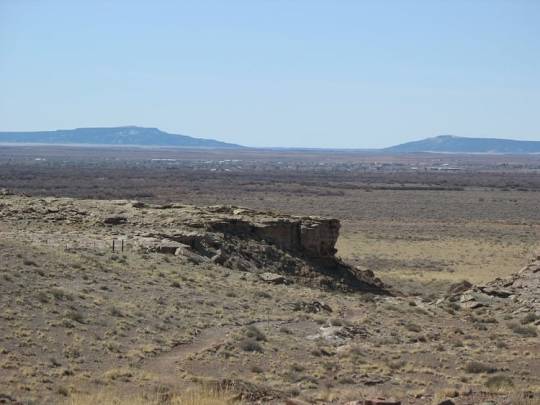
Homolovi
Homolovi or Homolovi State Park (formerly: Homolovi Ruins State Park) is a cluster of archaeological sites that contains the ruins of eight pre-Columbian Ancestral Puebloan (Anasazi) and Hopi pueblos in addition to some 300 other remains and petroglyphs. Homolovi lies within sight of the Little Colorado River in a floodplain, 2 km (4 miles) northeast of Winslow, Arizona in the United States. Archaeologists believe that Ancestral Puebloan peoples and the ancestors of the Hopi tribe once occupied these settlements, which spread out along a 32 km (19 miles) corridor on the Little Colorado River, at different intervals of time from c. 1250-1425 CE. Two pueblos - Homolovi I and Homolovi II - each contained more than 1,000 rooms in ancient times, and 40 ceremonial kivas are scattered throughout the park. The Homolovi ruins are unique in the ancient Southwest as they have helped archaeologists better understand the cultural transitions and social changes that occurred in the region during the 13th through 14th centuries CE. Four of the sites at Homolovi are listed on the U.S. National Register of Historic Places, and the park is currently managed by the Arizona State Park system.
Learn more about Homolovi
57 notes
·
View notes
Text
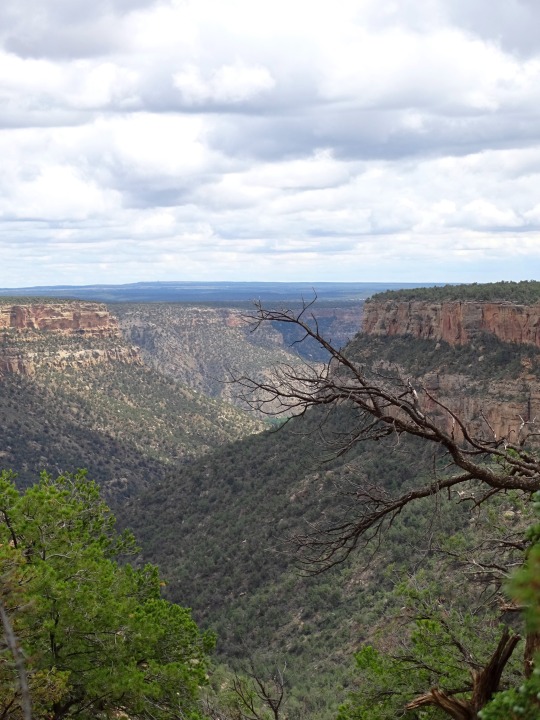
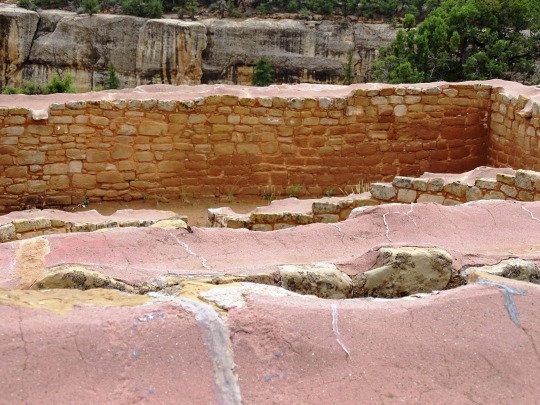

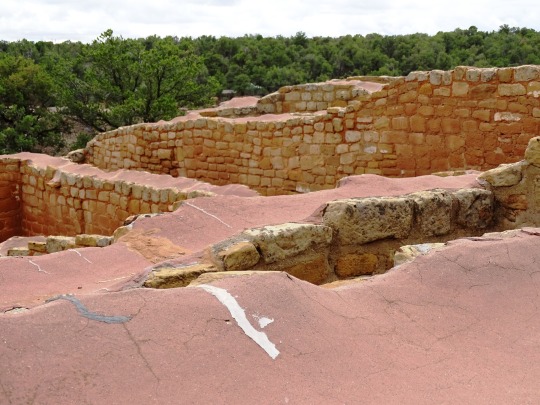


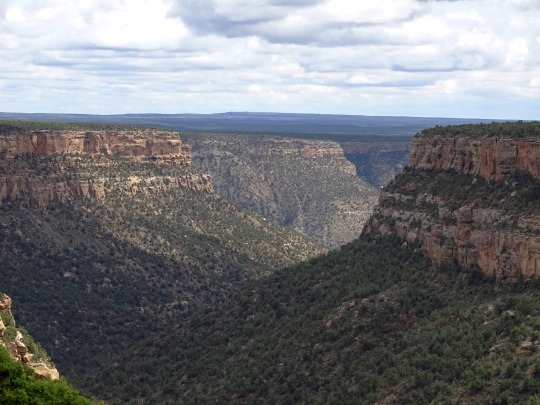



Mesa Verde National Park (No. 25)
Mesa Verde National Park, established in 1906, features some of the most well-preserved Ancestral Puebloan sites in the Southwest. More than 22,000 people may have lived on and around Mesa Verde at the beginning of the 1200s. But by the beginning of the 1300s, the area was depopulated, likely as a result of a prolonged drought or other social pressures. The inhabitants largely resettled in Arizona and the Rio Grande Valley of New Mexico, where their descendants live today as the Pueblo and Hopi people. (The park’s former inhabitants were once called the Anasazi, though the term – which is commonly cited as meaning “ancient enemy” in the Diné language – is considered derogatory by Pueblo people and has fallen out of use).
Mesa Verde’s crown jewels are its cliff dwellings, sprawling structures built in alcoves beneath the mesa tops, with likely uses including habitation, food storage, ceremony and ritual. More than 600 cliff dwellings are scattered throughout the park, though they represent just a fraction of the more than 5,000 known archeological sites within park boundaries.
Amid this archaeological treasure trove, Sun Temple stands out.
Source
#Sagebrush lizard#Mesa Verde National Park#Sun Temple#Ancestral Puebloans#Montezuma County#Native American history#Mountain West Region#UNESCO World Heritage Site#travel#original photography#vacation#tourist attraction#landmark#architecture#ruins#summer 2022#USA#archaeology#nature#flora#cliff#wildlfie#fauna#reptile#countryside
10 notes
·
View notes
Text
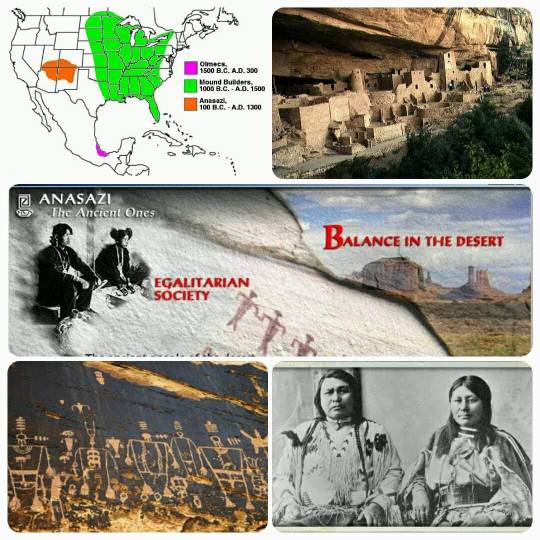
Anasazi Indians: The Ancestral Puebloans were an ancient Native American culture centered in present-day Four corners area of the United States, comprising Southern Utah, Northeastern Arizona, Northern New Mexico, and South Western Colorado.
They lived in a range of structures, including pit houses, pueblos, and cliff dwellings designed so that they could lift entry ladders during enemy attacks.
The people and their archaeological culture were historically called Anasazi from Navajo term Anaasazi, meaning "Ancient Ones"
Between 300B.C. and 100A.D., there were four distinct Indian cultures settled in SouthWest, Anasazi, Mogollon, Hohokam, and Sinagua. The fifth culture, the Fremont Indians settled primarily in Utah in 400A.D.
6 notes
·
View notes
Text
Chaco Canyon was incredibly remote. Kermit drove in on ten miles of very rough and rocky dirt roads. He was mad at his GPS taking him the back way, only to later discover the other road into the canyon was even worse!

He stayed the night in the campground. In the morning he did the loop drive to see all the ancient long houses, which had been reconstructed by an archeological team in the 1890s.
At the visitor center he learned that the Chacoans lived all over the state! From 900-1200 AD they seemed to be a trading hub--archaeologists uncovered fragments of cocoa beans from South America, exotic dyes, and even macaw bones! People must have traveled thousands of miles to this canyon in New Mexico to trade with the Choacans.
At the Park Ranger's advice, he did the six mile Pueblo Alto Loop hike, which took him rock scrambling up the cliff walls to the top of the bluffs, where he could see the ruins better than anyone on the ground.

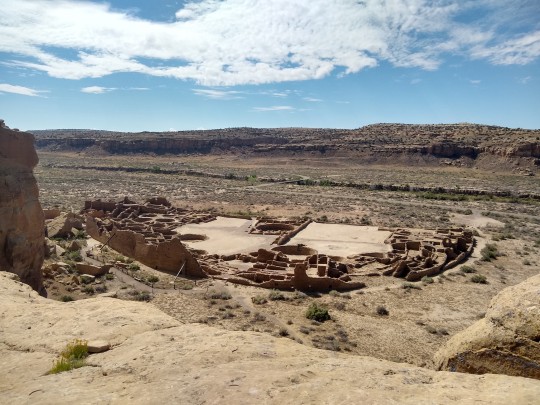
The hike was incredibly strenuous because of how much the trail dipped and climbed. The trail was marked mostly only by rock cairns, so it was easy to lose the path. At one point, the path required Kermit to scale the miniscule space between two boulders, wide enough only for one foot at a time.

Eventually he came to one of the coolest sights in the park: ancient Chacoan stairs carved into the cliff face! Apparently the Chacoans preferred to go over obstacles as opposed to around. Imagine them climbing up and down these stairs with baskets of trade goods strapped to their backs!

After the stairs, Kermit came to another ruin, which hikers were allowed to walk around in. The doors were very small, only a few feet high. According to Kermit's guide at Canyon De Chelly (more on that later), ancestral Puebloans were only a little more than five feet tall!

Kermit also passed a number of strange formations in the rock. Millions of years ago the entire valley was covered by water. These are old, fossilized shrimp burrows!
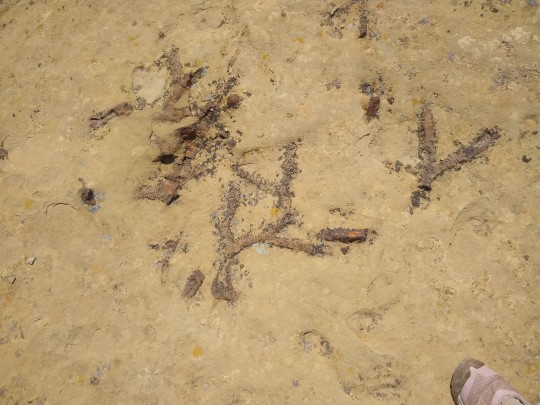

Finally, Kermit hiked back down, scrambling over boulders and between two massive rocks. It was time to leave the park, and he was so exhausted from hiking in the heat the he wanted to do nothing more than lay down in his car. His legs felt like jelly!
4 notes
·
View notes
Text
Chaco Culture National Historical Park, New Mexico, USA

For hundreds of years, New Mexico's Chaco Canyon served as a major cultural centre for Ancestral Puebloans as their communities took root and flourished. However, with long winters, little rain and short growing seasons, the high desert wasn't the easiest place to live. Despite these challenges, the Pueblo people found ways to thrive in the austere region. Today, the Chaco Culture National Historical Park offers a glimpse into the ancient Pueblo people's culture, traditions and values. The site is home to remnants of prehistoric ceremonial and public buildings, called great houses, which are characterised by an architectural style unique to the Pueblo culture. These large homes are modelled after ancient cliff dwellings and are made of limestone blocks or adobe bricks. Pueblo Bonito is the biggest and most popular great home in the park.
3 notes
·
View notes
Text
Hallmark Sets Four Movie Premieres for May: See the Schedule (ET Online Exclusive)

HALLMARK CHANNEL
All premieres are at 8 p.m. ET/PT.
Dream Moms
Starring: Tamera Mowry-Housley, Chelsea Hobbs, Roger Cross and Andrew J. Hampton
Premieres: Saturday, May 13
Danielle (Mowry-Housley), a one-time off-Broadway performer and former backup singer, and Claire (Hobbs), a once-aspiring dancer, both had dreams of making it to the Broadway stage. Many failed auditions and years later, Danielle is married Mark (Cross), a successful lawyer, and has a ballerina daughter, who is positioned for NYC ballet, living in the Upper East Side. Claire is a single mother raising two sons and working as a bookkeeper in the Garment District. Now consumed with motherhood, they no longer have time for themselves and have deferred their own dreams. Danielle’s brother RJ (Hampton) introduces the two after Claire begins taking classes at his dance studio. He is impressed with Claire’s dance technique and wants to bring the women together to compete in a nationally televised talent contest. As they start practicing for the show, Danielle and Claire begin to regain their sense of self and passion they once had as performers. When competing priorities arise with their families and cause them to reconsider, the pair ultimately realize they need to show up for themselves and set an example to never give up your dreams. They compete in the talent contest and with the support of their families, Danielle and Claire learn it’s never too late to become what or who you want to be.
Love in Zion National: A National Park Romance
Starring: Cindy Busby and David Gridley
Premieres: Saturday, May 20
Lauren (Busby) is an assistant curator who is out to prove a set of ancient vases belongs with the Pueblo Nation. She journeys to Zion to find what she needs to make her case and along the way meets Adam (Gridley), a native Puebloan park ranger, who helps her on mission.
HALLMARK MOVIES & MYSTERIES
All premieres are at 7 p.m. ET/PT.
A Jane Da Silva Mystery: Case of the Broken Song (working title)
Starring: Jodie Sweetin and Stephen Huszar
Premieres: Sunday, May 14
Singer Jane DaSilva (Sweetin) inherits the family foundation which is a non-profit detective agency that helps people who aren’t able to help themselves. Jane’s Aunt Sadie (Paris Jefferson) and Detective John Cameron (Huszar) act as her mentors as she takes on her first case surrounding a mother’s untimely death years before. As Jane investigates a multi-level marketing company that took advantage of her client’s (Danielle Smith) fragile mom, she realizes that digging up the past can be dangerous...
Carrot Cake Murder: A Hannah Swensen Mystery (working title)
Starring: Alison Sweeney, Cameron Mathison and Barbara Niven
Premieres: Sunday, May 21
The discovery of a skeleton amid the rubble of a building undergoing renovation reveals that one of Lake Eden’s beloved citizens is not who he claimed to be. Much to the dismay of her fiancé, Detective Mike Kingston (Mathison), Hannah (Sweeney) begins to investigate the case on her own. As she tries to piece together the events that led to the murder and tries to learn the victim’s true identity, Hannah even calls on her mother Delores (Niven) as she works to bring the killer to justice and uncover the truth.
Clink this LINK to read the full article at ETOnline.
#news#hallmark movies#schedule#dream moms#tamera mowry housley#chelsea hobbs#love in zion national#a national park romance#cindy busby#david gridley#hallmark channel#a jane da silva mystery: case of the broken song#jodie sweetin#stephen huszar#carrot cake murder: a hannah swensen mystery#alison sweeney#cameron mathison#barbara niven#hallmark movies & mysteries#link#hannah swensen mysteries
3 notes
·
View notes
Text
Painted Hand Pueblo is a perfect example of what makes anthropology fun
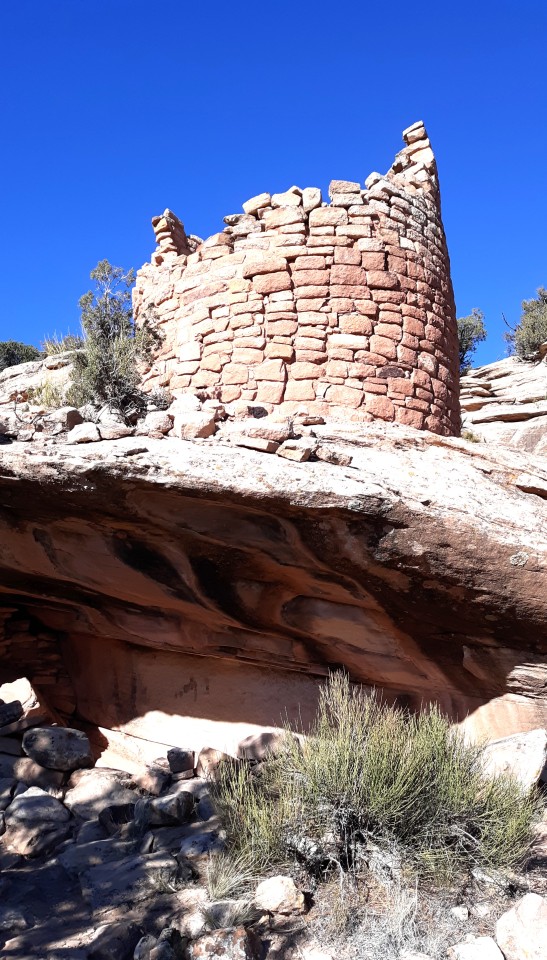
This is Painted Hand Pueblo, a ruin found in the Canyon of the Ancients National Monument in Colorado. This was my first stop on my Thanksgiving roadtrip, and I think it's a perfect example of what makes anthropology so much fun even when you're not an actual professional anthropologist.
I have a love of ancient Puebloan (sometimes called the Anasazi) ruins. I find their architecture, especially their late architecture, beautiful. Of all the human historical sites I've been to, Puebloan ruins would top my list. You know that meme where the car is suddenly going for the exit on a highway? That is literally me with Puebloan ruins - as with this one. As I climbed down the canyon wall to get closer, I began extrapolating what I could about this pueblo.
it was clearly built in the later centuries of the ancient Puebloan civilization.
Right?
But why did I think that?
This is why anthropology is so fun. Because I was right. Painted Hand Pueblo was built in the 1300s, which is when the ancient Puebloan civilization was in its decline.
To understand how I came to this conclusion, let's look at the ruins of Mesa Verde.

Pithouse, above. Kiva, below
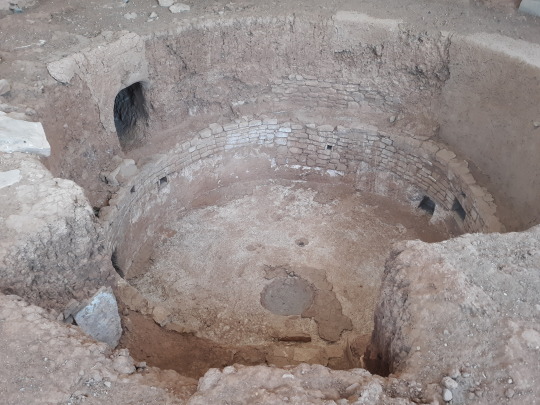
The earliest ruins belong to the Basketweavers, built around 500 CE. Later ruins from around 950, however, look to have been influenced by the Chacoan people. Yes. As in Chaco Canyon.
Now if you remember from my previous post about Chaco Canyon, Chaco Canyon was at its height between 900 and 1100.

See those circular rooms? Those are traditional kivas. Chaco Canyon's influence is a fantastic example of how ancient Puebloan architecture changed over centuries, from shallow pithouses, to kivas and roomblocks, to the classical Puebloan cliff dwellings and other multi-story structures.
... Like the Painted Hand Pueblo.
However, Chaco Canyon and Painted Hand Pueblo are, like, 150 miles away from each other. Obviously, these architectural influences take some time to disseminate. The ancient Puebloans mostly migrated north, over several centuries, that ebbed and flowed depending on the seasons and geological changes.
This is how Painted Hand Pueblo was built in the 1300s, centuries after the height of Chaco Canyon. This gap came from the natural boundaries of how fast people migrated.
So yeah, anthropology is fascinating.
Sources: 1, 2, 3, 4, 5, 6, 7 (Photos are mine tho :P)
#this has been education hour with mits#this trip's text posts will be more educational#so i hope everyone enjoys#the dumbest shit in the weirdest places#traveling#travel#road trip#driving#photo#photography#national park#national monument#canyon of the ancients#canyon of the ancients national monument#mesa verde#mesa verde national park#ruins#ancient pueblos
2 notes
·
View notes
Photo
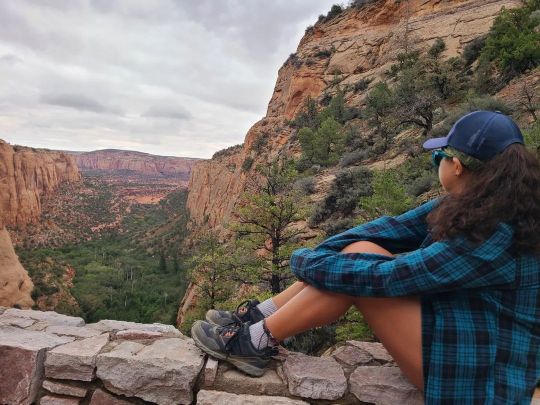
An oasis in an arid desert where ancient Puebloan people dwelled along the mountain side back 1250-1280 AD #navajonationalmonument #betatakincanyon #betatakin #arizona #arizonaraftingadventures #hikingadventures #hiking #hikingarizona🌵☀️ #adventureisoutthere #geologist #geology #lifeasageologist (at Navajo National Monument) https://www.instagram.com/p/CigsNC5L_Mx/?igshid=NGJjMDIxMWI=
#navajonationalmonument#betatakincanyon#betatakin#arizona#arizonaraftingadventures#hikingadventures#hiking#hikingarizona🌵☀️#adventureisoutthere#geologist#geology#lifeasageologist
1 note
·
View note
Text
Alliance of Resolve (Ep.2)
The crimson hues of the setting sun painted the land with a surreal sense of serenity as William Flint stood amidst the remains of his once vibrant ranch. He stood beside the fresh graves of his beloved wife, Maria, and young son, Javier. The charred remnants of their home whispered the tale of tragedy, a story etched into his very soul.
As the shadows grew longer, a figure emerged from the horizon, a member of the Puebloan tribe, to which had been a part of his families very demise. The man, approached cautiously, his hands raised in a gesture of peace. He introduced himself and expressed condolences for the losses both had suffered “William? I am Kaiweh, I am deeply sorry for your losses that lay at your very feet, we too, understand the pain of this”. The bandits had not only razed William's life but had also attacked Kaiweh's people, leaving death and destruction in their wake.
William, in turn, recounted the events that led to this grim moment. The desperation for land, the unexplained animosity, and the heart-wrenching loss of his family. Kaiweh listened attentively, his face reflecting the pain he heard in William's tale.
Amidst the sorrow, William, fueled by a growing desire for justice, took a step forward. He looked at Kaiweh and made a proposition, his voice tinged with determination. "Let us forge an alliance, a quid pro quo. I seek vengeance for my family, and you seek retribution for your people. If I aid you in facing these bandits, will you in turn stand by me in my quest to find my daughter?"
Kaiweh acknowledged William's proposition with a solemn nod, understanding the gravity of the situation and the need for cooperation. He extended a reciprocal offer that could tip the scales of this looming confrontation. "In the spirit of this alliance," he replied, a sense of purpose underscoring his words, "I shall provide you with crucial information—the bandits you seek are hiding within the nearby Sangre de Cristo Mountains." The weight of their common goal hung heavy in the air, solidifying the pact that had been made. The party of four was forged—William, Kaiweh, and two more of Kaiweh’s family, Tashka, and Kokyangwuti.
The Puebloan tribe had their own way of preparing for battle; they invited William to partake in their ancient rituals, including the Dance of Strength and Unity. William, whilst holding very little in the way of choices, graciously accepts the offer and with a last glance at the fresh graves, he turns to the mission at hand.
In a quiet corner of the pueblo, beneath the vast open sky that stretched across the land like a vast canvas, the puebloan tribe prepared for a crucial ceremony. A bonfire crackled, its flames reaching toward the heavens. Surrounding the fire, members of the tribe adorned in traditional garments chanted ancient prayers, their voices resonating with a rhythmic pulse that seemed to bind the very air with a sacred reverence.
Kaiweh led William to the heart of this ceremony, the flickering fire casting a play of light and shadows across their faces. The air was thick with the scent of burning sage and sweetgrass, carrying with it the promise of purification and strength. The dance of flames seemed to mirror the dance of souls, a reminder of the eternal struggle between light and darkness, good and evil.
In this profound atmosphere, Kaiweh stood before William, his eyes reflecting the solemnity of the moment. Around them, the chanting rose and fell like a gentle tide, guiding the rhythm of this ancient communion. The chief, his bearing regal and wise, held a stone dagger—an emblem of strength and resilience.
As the tribe chanted, the chief presented the stone dagger to William. It was a weapon forged from flint, a symbol of unwavering determination. The hilt, crafted from deer bone, represented the spirit of the land and its people, bound together by resilient plant fibers, a testament to the enduring unity that held the tribe. The sheath, intricately woven and adorned with turquoise and owl feathers, epitomized the traditions, wisdom, and spirit that they now shared with William.
In this sacred circle, amidst the fervent prayers and the scent of sage, the significance of the stone dagger was amplified. It was not merely a tool of retribution; it was a profound symbol of their alliance—a bond that transcended blood, forged in the fires of sorrow and determination. The ritual's sanctity underscored the weight of their offering, the hope it bore, and the promise it held.
In the wake of the profound ritual, the tribe prepared William and his companions for their journey. The air was charged with a sense of purpose, the ancient chants still lingering in their ears like a benevolent echo. With a ceremonial blessing, they were anointed with sacred oils, a symbolic gesture representing purity and protection on their perilous quest.
Bathed in the flickering firelight's glow, the group stood in a circle, their faces resolute, and their hearts intertwined in purpose. Kaiweh spoke with solemnity, reminding them of the task that lay ahead—the retribution they would seek, the justice they would strive for, and the hope that bound them all. With the stone dagger as a focal point, they pledged their dedication to the cause.
As the night wore on, the tribe gathered provisions for their journey. Pouches were filled with dried meat, woven bags adorned with protective symbols were handed out, and water skins were replenished with fresh, clear water. The shaman offered words of encouragement and protection, beseeching the spirits of the land to watch over them.
Armed with determination and unity, they set forth into the darkness, the echoes of the ritual guiding their steps and the promise of justice illuminating their path. Their hearts were set on the horizon, where the towering Sangre de Cristo Mountains stood as a formidable backdrop to their quest. The stone dagger, a symbol of alliance and strength, rested at William's side, a constant reminder of the weight of their purpose.
Their journey took them to the foothills of the Sangre de Cristo Mountains. Moving cautiously, and using the skills possessed by Kokyangwuti, they tracked the bandits to a deep canyon, likely to increase their safety in the face of any opposition. Knowing they were outnumbered two-to-one, William knew that a plan was needed, with a confidence and a manner that appeared steeped with experience he proposed “Tashka and Kokyangwuti would attack from the east, providing a diversion. Drawing from my military experience, decoy tactics often proved effective in our operations. This diversion would allow myself, alongside Kaiweh, to strike from the west and catch the bandits off guard.” Whilst a little stunned that William had never mentioned much of his background let alone a hardened battle tested knowledge, Kaiweh accepted and with the blind acceptance from the remaining party members.
As darkness shrouded the rugged terrain, the plan unfolded. With silent precision, Tashka and Kokyangwuti moved through the thicket of Manzanita and Chokecherry bushes to the east side of the bandits' camp. Without a moment’s hesitation, Tashka let out an intimidating cry that startled even William, who knew what was about to ensue. The bandits leapt to their feet and with hurried voices and a confusion in command, headed towards the rocky and bushy outcrop located at the eastern point of the camp.
The element of surprise was on their side. The bandits were caught off guard which allowed William and Kaiweh to swiftly move through the camp, reaching the first bandit that was holding the rear, William's new stone dagger found its mark, thrust into the throat of the unsuspecting man and with an outward motion the knife that had been presented to William, ripped a hole through the throat of the bandit. Kaiweh, simultaneously, slashing a large laceration into the neck of the second bandit to be reached. Still undetected and down to 6 enemies, William nimbly manoeuvred around a large boulder near the flickering fire of the camp and just has he approached another unsuspecting member of the bandits, he turned and attempted to cry out, letting the others know, however, William reactively punched the man straight in the throat, rendering him not only incapacitated, physically, but also unable to talk, Kaiweh swiftly moved in and proceeded to stab the man several times in the chest. The bandits were falling one after another, but due to ferocious stabbing motion of Kaiweh, the element of surprise was lost, and the remaining bandits turned to recognize the decoy and regrouped to defend themselves. Cocking their revolvers and aiming them towards William and Kaiweh, it was as if they had totally forgotten the threat from the east. With the sudden change in direction, and from a new vantage point, Tashka and Kokyangwuti, appeared from the thicket and fired multiple arrows towards the remaining bandits. Multiple thuds could be heard as arrows found their home, piercing the bodies of three bandits, dropping them to their knees, subsequently followed by their last painful breaths.
The bandits had fought fiercely, their resolve unyielding but few remained. Realizing that a dead man is a silent man, William shouted to keep one alive. With a clear message sent, the two remaining bandits surrender, raising their hands in submission.
Grabbing the bandits from behind and disarming them, Tashka and Kokyangwuti restrained the two whilst William asked questions. Despite their surrender, the bandits were reluctant to share any information. Infuriated and frustrated, William grabbed the bigger man and dropped him to his knees by the fire, clutching him by the collar of his shirt and jacket, he forced the mans face over the naked flame. The smell of burnt flesh and ringing of the screams resonated throughout the canyon. The extreme heat from the flame appeared to cause little impact to William as his sleeve began to burn, he shouts, “Tell me, tell me where she is!”. The screaming came to a shivering silence, and the mans body fell flat into the flames without a twitch! Undeterred, William grabbed the second man, who fell instantly to his knees whimpering and pleading “I’ll tell you anything, please, I will I promise!”
Sweat trickled down his brow as he spilled the truth, barely able to hold his composure as he knelt feet from the burning remains of his compatriot. "There was this rich man from Texas, Fort Worth I think," he stammered, "and a local man, he’s always at the Rancho Rooster Saloon." The fear in his eyes intensified. "We were all part of this, but we weren’t in the meeting in Santa Fe. The Texan visitor, cloaked in power and protected by authorities, had motives that seemed beyond money, maybe for power." He was almost pleading now, desperate to unburden his secret. "The reason for seizing the land, I don’t know, but it was hinted to be of immense worth. Oddly, Jorge, he’s the one who got us into this, distanced himself from the raid on the ranch, choosing to stay at the man from Espanola’s place, maybe to help with any local law officials, who knows!" He could hardly get the words out. "This man, a regular visitor to the saloon, he knew everybody in the community and knew the Texan and helped with his interests." He hesitated, then blurted, "I... I couldn't tell you where they took the girl. That secret is way beyond my knowledge! Maybe the man from Espanola or Jorge knows." His panic was palpable, his confession laid bare. “Sir, I have told you all I know, I bare no ill will towards you, if you let me go you will never see me again!”.
A surge of rage and frustration coursed through William. He knew the man from Espanola must be the same man that he had spoken to in the saloon the nights previous. He and the bandits had stolen not only his family but his sense of justice. Listening to the confession and pleads being made by the last remaining bandit did not change the sense of anger and rage that he felt, in fact it intensified it! He grabbed the man from the clutches of Kokyangwuti, and threw him over the nearby ledge, 100ft to the rocky sharp bottom, a thud and then silence.
Retribution was found and the deal fulfilled. Kaiweh indicated that Tashka and Kokyangwuti were free to return home, the ongoing burden sat purely on Kaiweh’s shoulders now. As the party halved in size, they decided the best course of action was to return to the saloon, to seek the truth by confronting the man who obviously had his hands in the dark corners of the town.
With the darkness as their witness and the mountains as their sentinel, they prepared to unveil the twisted secrets that bound their fates.
1 note
·
View note
Text
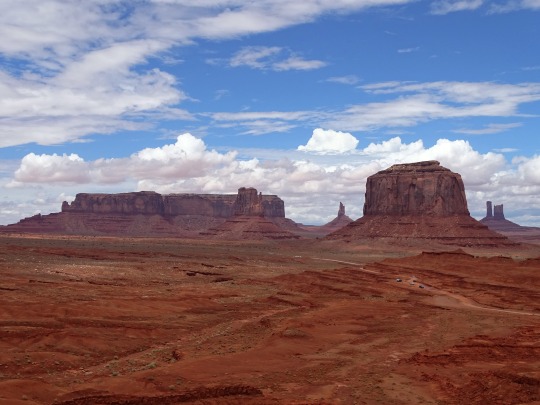


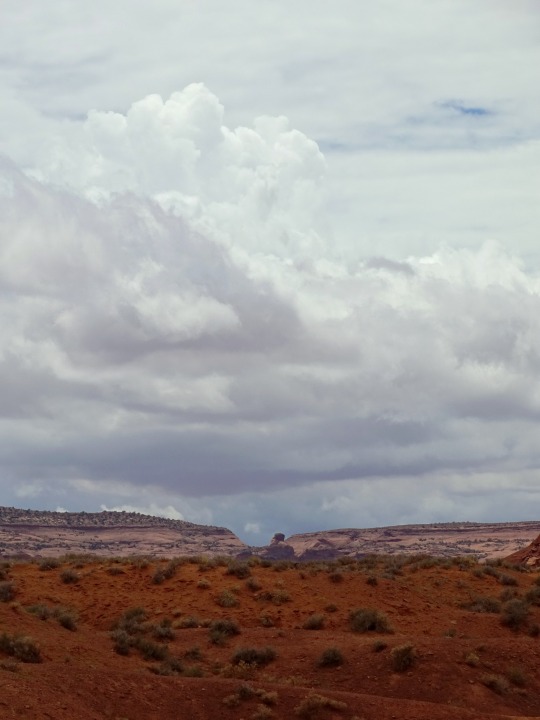


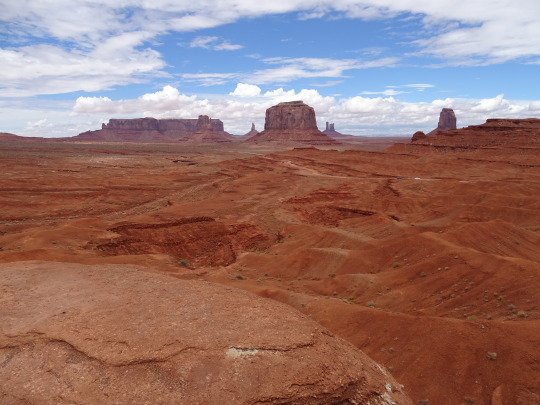



Monument Valley, AZ (No. 9)
The earliest people to mark the area were the Anasazi, or Ancestral Puebloans, who settled in around 1200 BCE. Their art and building structures remain, hinting at an ancient resourcefulness that found promise in a foreboding desert.
The Navajo culture took root centuries before Spaniards entered the area in 1581, and 250,000 of their descendants still live on the 16-million-acre Navajo Nation. Monument Valley is a window into their culture. Explore their history, their way of life, their cuisine and their art. You can even take a little home in the form of handmade jewelry or a dyed wool rug.
Monument Valley isn't a national park. It's not even a national monument. But it's as American as it gets.
Movie Magic
Monument Valley captured a larger audience’s attention via director John Ford’s Westerns. Beginning with 1939’s “Stagecoach,” starring John Wayne, Ford’s many happy returns to Monument Valley shaped how much of the outside world pictures the American West.
It has since been featured as a backdrop in countless movies, including 1994’s “Forrest Gump.” Put on your smiley face T-shirt and a trucker hat to pose at the finish line — you know, where the title character said he was tired. Groupies not required.
Source
#Three Sisters#John Ford Point#travel#original photography#vacation#tourist attraction#landmark#architecture#landscape#countryside#flora#nature#grass#Navajo County#Navajo Nation#Southwestern USA#Colorado Plateau#Monument Valley#rock formation#summer 2022#Arizona#desert#blue sky#clouds
3 notes
·
View notes
Text
Ancient American Magazine
Unveiling the Mysteries of the Ancient Americas: Exploring the Riches of Ancient American Magazine
In the realm of historical exploration and archaeological wonder, Ancient American Magazine stands as a beacon of knowledge, inviting readers to embark on a captivating journey through the enigmatic past of the Americas. Stepping back in time, this exceptional publication opens the doors to a world shrouded in mystery, shedding light on the civilizations, cultures, and achievements that once graced the continents long before the arrival of Columbus.
Journey through Time: The pages of Ancient American Magazine serve as a portal to eras long gone, where Native American cultures thrived in harmony with their surroundings. This publication's commitment to authentic historical research allows readers to delve into the depths of ancient societies, unveiling artifacts, architecture, and art that speak volumes about the peoples who crafted them. From the Aztecs and Maya to the Incas and Ancestral Puebloans, the magazine spans across the entirety of the Americas, painting a holistic picture of a past that often remains elusive.
0 notes
Text
Sedona, Arizona

From the moment you step foot in Sedona, Arizona, you will be mesmerised by the stunning vistas and tall red sandstone cliffs jutting from the desert floor. Adventure enthusiasts will appreciate the beauty and serenity of the many trails that dot the region. Sedona is also steeped in Native American history. Although little is known about the earliest settlers in the region due to a lack of written history, they are referred to as 'Ancestral Puebloans.' It is believed they inhabited the area around 1,400 years ago. Most of the information about these ancient people comes from the archaeological ruins that remain, which include huge pueblo complexes that serve as the only vestiges of their glorious past. Other Native American groups that came to the area are the Hakataya, the Hohokam, the Sinagua and the modern-day tribes that live in Arizona today, the Tonto Apaches and the Yavapai.
1 note
·
View note
Text

Cliff Palace, Mesa Verde NM
The Ancestral Puebloans, also known as the Anasazi, were an ancient Native American culture that spanned the present-day Four Corners region of the United States, comprising southeastern Utah, northeastern Arizona, northwestern New Mexico, and southwestern Colorado.[1] They are believed to have developed, at least in part, from the Oshara tradition, which developed from the Picosa culture. The people and their archaeological culture are often referred to as Anasazi, meaning "ancient enemies", as they were called by Navajo. Contemporary Puebloans object to the use of this term, with some viewing it as derogatory.[2][3]
The Ancestral Puebloans lived in a range of structures that included small family pit houses, larger structures to house clans, grand pueblos, and cliff-sited dwellings for defense. They had a complex network linking hundreds of communities and population centers across the Colorado Plateau. They held a distinct knowledge of celestial sciences that found form in their architecture. The kiva, a congregational space that was used mostly for ceremonies, was an integral part of the community structure.
Archaeologists continue to debate when this distinct culture emerged. The current agreement, based on terminology defined by the Pecos Classification, suggests their emergence around the 12th century BC, during the archaeologically designated Early Basketmaker II Era. Beginning with the earliest explorations and excavations, researchers identified Ancestral Puebloans as the forerunners of contemporary Pueblo peoples.[1][3] Three UNESCO World Heritage Sites located in the United States are credited to the Pueblos: Mesa Verde National Park, Chaco Culture National Historical Park and Taos Pueblo.
0 notes
Text
I wanna talk about the Salmon Ruins
I really can't explain in a way that doesn't make me sound like a raving lunatic how cool the cultural and chronological differences in architecture of a specific region are. Like. That sentence. Read it back? Sounds fuckin crazy. Why do I care about this? idk. I just think it's neat.
So.
Salmon Ruins. Really, I'd never heard of these ruins before I really started learning more about ancestral Puebloan (and specifically Chacoan) architecture.
Yeah, I'll be completely fucking honest, my reasons for getting into Chacoan architecture are dumb at best. At best. I'd have to trace back so many things. What led me to the Salmon Ruins? Probably, I think it started by joining a tour group that I did not pay for in Mesa Verde.
I'm 90% sure the tour guide knew I wasn't in his group, but what was he gonna do? Tell me to go away? Nah. So I tagged along because it was interesting. This tour was about the mesa part of Mesa Verde - not the cliff dwellings - mostly focusing on the early settlements and kivas. I'd been to the Manitou Cliff Dwellings as a kid, back when they called the ancestral Peubloans 'the Anasazi'. It was cool, but didn't really spark my interest outside of being there. But kivas?
I'd never heard of these things before. And there were so many! And so deep! How they were built, how they were used, who inhabited them, all new information to me. I'm sure they talked about it at the Manitou Cliff Dwellings but, ya know, you don't listen to that stuff as a kid.
Mesa Verde led me to Chaco Canyon. And Chaco Canyon (while terrifying to get in and out of) is beautiful. You could pick a 5x5 part of the outer wall of that site to study for an entire day.
The Chacoans cared about their buildings. They made art with their homes. This was beyond necessity, this was purposeful. And it was so close I could literally touch it. I could walk in the city and see what they saw from the same place they saw it. I could go on about Chaco Canyon (as I have in the past), but moving on.
Chaco Canyon led to Canyon of the Ancients, lead to Aztec Ruins, and then finally to the Salmon Ruins. Mind you - there are more sites that I haven't seen yet. They are scattered across New Mexico, Arizona, and Colorado, literally dozens of sites. I've probably seen more than most, but I've certainly not seen all of them.
But the Salmon Ruins are special in their own way, and that comes specifically from their research library. When you enter the site, they'll hand you a little laminated booklet that you return to the front office after seeing the site. That includes a map of the full site, a detailed history of its re-discovery and preservation, and most importantly - a color guide to take you to each important marker placed in the ruins.
This guide is gorgeous. The amount of information you get as you go is just amazing. It goes over common practices, tools, room usages, inhabitants, changes to the structure, everything. Personally, I found Markers 1 and 16 most interesting.
These focus on the craftsmanship specific to the people living there at the times they occupied Salmon Pueblo. Because you can tell! Who was living there! Based off how they built and rebuilt things!
Fascinating!!!!
The Chacoans used very geometrically similar rocks - think almost brick-like, cut to fit - to create the outer layer of their walls, while filling the insides of the walls with large, unshaped stones (Chacoan style core and veneer masonry). They would also decorate their walls by taking these stones and exposing them to heat to change their colors (because again!! The Chacoans!! Made their homes into art!!)
This style of masonry is not shared among all ancestral Puebloans, and when the Chacoans no longer inhabited Salmon Pueblo, other ancestral Peubloans occupied it and modifications to its structure were made in a different style, with large river rocks held together with mortar.
You can follow the Chacoans and their influence to every site they created and interacted with, including Mesa Verde and Chimney Rock in Colorado.
Idk. Maybe at some point I'm going to buy a big ole fuckin ream of paper and spread it out around my house so I can draw out and fully appreciate the chronological and geological changes and dispersion of Chacoan architecture. Maybe at some point I'll hit that level of out to lunch that it will seem like a good idea to do that.
Maybe I'm actively thinking about doing this.
Maybe I went and bought a copy of the booklet you can walk around the Salmon Ruins with. Maybe I specifically asked for one after I was done looking around.
#who knows?#the dumbest shit in the weirdest places#chaco culture#chaco canyon#ancestral peubloans#mits did you just write an entire post to talk about really old walls? MAYBE
1 note
·
View note